
Holt Mcdougal Larson Pre-algebra: Student Edition 2012
1st Edition
ISBN: 9780547587776
Author: HOLT MCDOUGAL
Publisher: HOLT MCDOUGAL
expand_more
expand_more
format_list_bulleted
Question
Chapter 11.1, Problem 10E
To determine
To calculate: to make a histogram and frequency table.
Expert Solution & Answer
Answer to Problem 10E
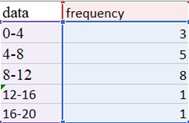
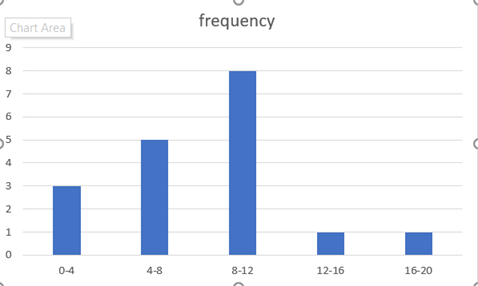
Explanation of Solution
Given information: consider, thedataprovided in the question,

Calculation: first make the intervals for frequency table.
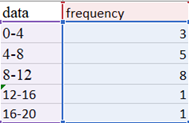
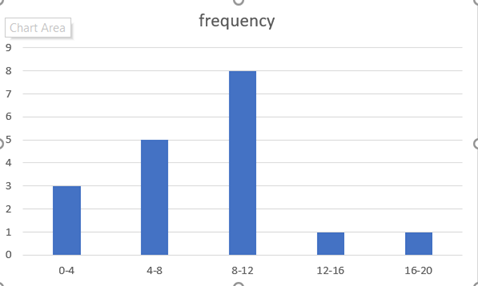
Hence,
Thus,
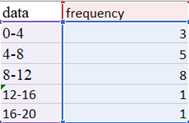
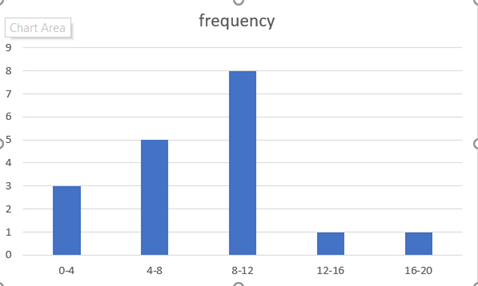
.
Chapter 11 Solutions
Holt Mcdougal Larson Pre-algebra: Student Edition 2012
Ch. 11.1 - Prob. 1CCh. 11.1 - Prob. 1ECh. 11.1 - Prob. 2ECh. 11.1 - Prob. 3ECh. 11.1 - Prob. 4ECh. 11.1 - Prob. 5ECh. 11.1 - Prob. 6ECh. 11.1 - Prob. 7ECh. 11.1 - Prob. 8ECh. 11.1 - Prob. 9E
Ch. 11.1 - Prob. 10ECh. 11.1 - Prob. 11ECh. 11.1 - Prob. 12ECh. 11.1 - Prob. 13ECh. 11.1 - Prob. 14ECh. 11.1 - Prob. 15ECh. 11.1 - Prob. 16ECh. 11.1 - Prob. 17ECh. 11.1 - Prob. 18ECh. 11.1 - Prob. 19ECh. 11.1 - Prob. 20ECh. 11.1 - Prob. 21ECh. 11.1 - Prob. 22ECh. 11.1 - Prob. 23ECh. 11.1 - Prob. 24ECh. 11.1 - Prob. 25ECh. 11.1 - Prob. 26ECh. 11.1 - Prob. 27ECh. 11.1 - Prob. 28ECh. 11.1 - Prob. 29ECh. 11.1 - Prob. 30ECh. 11.2 - Prob. 1CCh. 11.2 - Prob. 1ECh. 11.2 - Prob. 2ECh. 11.2 - Prob. 3ECh. 11.2 - Prob. 4ECh. 11.2 - Prob. 5ECh. 11.2 - Prob. 6ECh. 11.2 - Prob. 7ECh. 11.2 - Prob. 8ECh. 11.2 - Prob. 9ECh. 11.2 - Prob. 10ECh. 11.2 - Prob. 11ECh. 11.2 - Prob. 12ECh. 11.2 - Prob. 13ECh. 11.2 - Prob. 14ECh. 11.2 - Prob. 15ECh. 11.2 - Prob. 16ECh. 11.2 - Prob. 17ECh. 11.2 - Prob. 18ECh. 11.2 - Prob. 19ECh. 11.2 - Prob. 20ECh. 11.2 - Prob. 21ECh. 11.2 - Prob. 22ECh. 11.2 - Prob. 23ECh. 11.3 - Prob. 1CCh. 11.3 - Prob. 2CCh. 11.3 - Prob. 1ECh. 11.3 - Prob. 2ECh. 11.3 - Prob. 3ECh. 11.3 - Prob. 4ECh. 11.3 - Prob. 5ECh. 11.3 - Prob. 6ECh. 11.3 - Prob. 7ECh. 11.3 - Prob. 8ECh. 11.3 - Prob. 9ECh. 11.3 - Prob. 10ECh. 11.3 - Prob. 11ECh. 11.3 - Prob. 12ECh. 11.3 - Prob. 13ECh. 11.3 - Prob. 14ECh. 11.3 - Prob. 15ECh. 11.3 - Prob. 16ECh. 11.3 - Prob. 17ECh. 11.3 - Prob. 18ECh. 11.3 - Prob. 19ECh. 11.3 - Prob. 20ECh. 11.3 - Prob. 21ECh. 11.3 - Prob. 22ECh. 11.3 - Prob. 23ECh. 11.3 - Prob. 24ECh. 11.3 - Prob. 25ECh. 11.3 - Prob. 26ECh. 11.4 - Prob. 1CCh. 11.4 - Prob. 1ECh. 11.4 - Prob. 2ECh. 11.4 - Prob. 3ECh. 11.4 - Prob. 4ECh. 11.4 - Prob. 5ECh. 11.4 - Prob. 6ECh. 11.4 - Prob. 7ECh. 11.4 - Prob. 8ECh. 11.4 - Prob. 9ECh. 11.4 - Prob. 10ECh. 11.4 - Prob. 11ECh. 11.4 - Prob. 12ECh. 11.4 - Prob. 13ECh. 11.4 - Prob. 14ECh. 11.4 - Prob. 15ECh. 11.4 - Prob. 16ECh. 11.4 - Prob. 17ECh. 11.4 - Prob. 18ECh. 11.4 - Prob. 19ECh. 11.4 - Prob. 20ECh. 11.4 - Prob. 21ECh. 11.4 - Prob. 22ECh. 11.4 - Prob. 23ECh. 11.4 - Prob. 24ECh. 11.4 - Prob. 25ECh. 11.4 - Prob. 26ECh. 11.4 - Prob. 27ECh. 11.5 - Prob. 1CCh. 11.5 - Prob. 1ECh. 11.5 - Prob. 2ECh. 11.5 - Prob. 3ECh. 11.5 - Prob. 4ECh. 11.5 - Prob. 5ECh. 11.5 - Prob. 6ECh. 11.5 - Prob. 7ECh. 11.5 - Prob. 8ECh. 11.5 - Prob. 9ECh. 11.5 - Prob. 10ECh. 11.5 - Prob. 11ECh. 11.5 - Prob. 12ECh. 11.5 - Prob. 13ECh. 11.5 - Prob. 14ECh. 11.5 - Prob. 15ECh. 11.5 - Prob. 16ECh. 11.5 - Prob. 17ECh. 11.5 - Prob. 18ECh. 11.5 - Prob. 19ECh. 11.5 - Prob. 20ECh. 11.5 - Prob. 21ECh. 11.5 - Prob. 22ECh. 11.5 - Prob. 23ECh. 11.5 - Prob. 24ECh. 11.5 - Prob. 25ECh. 11.5 - Prob. 26ECh. 11.6 - Prob. 1CCh. 11.6 - Prob. 2CCh. 11.6 - Prob. 3CCh. 11.6 - Prob. 4CCh. 11.6 - Prob. 5CCh. 11.6 - Prob. 6CCh. 11.6 - Prob. 7CCh. 11.6 - Prob. 8CCh. 11.6 - Prob. 1ECh. 11.6 - Prob. 2ECh. 11.6 - Prob. 3ECh. 11.6 - Prob. 4ECh. 11.6 - Prob. 5ECh. 11.6 - Prob. 6ECh. 11.6 - Prob. 7ECh. 11.6 - Prob. 8ECh. 11.6 - Prob. 9ECh. 11.6 - Prob. 10ECh. 11.6 - Prob. 11ECh. 11.6 - Prob. 12ECh. 11.6 - Prob. 13ECh. 11.6 - Prob. 14ECh. 11.6 - Prob. 15ECh. 11.6 - Prob. 16ECh. 11.6 - Prob. 17ECh. 11.6 - Prob. 18ECh. 11.6 - Prob. 19ECh. 11.6 - Prob. 20ECh. 11.6 - Prob. 21ECh. 11.6 - Prob. 22ECh. 11.6 - Prob. 23ECh. 11.6 - Prob. 24ECh. 11.6 - Prob. 25ECh. 11.6 - Prob. 26ECh. 11.6 - Prob. 27ECh. 11.6 - Prob. 28ECh. 11.6 - Prob. 29ECh. 11.6 - Prob. 30ECh. 11.6 - Prob. 31ECh. 11.6 - Prob. 32ECh. 11.6 - Prob. 33ECh. 11.6 - Prob. 34ECh. 11.6 - Prob. 35ECh. 11.6 - Prob. 36ECh. 11.6 - Prob. 37ECh. 11.6 - Prob. 38ECh. 11.6 - Prob. 39ECh. 11.6 - Prob. 40ECh. 11.6 - Prob. 41ECh. 11.6 - Prob. 42ECh. 11.6 - Prob. 43ECh. 11.6 - Prob. 44ECh. 11.6 - Prob. 45ECh. 11.6 - Prob. 46ECh. 11.6 - Prob. 47ECh. 11.6 - Prob. 48ECh. 11.6 - Prob. 49ECh. 11.6 - Prob. 50ECh. 11.7 - Prob. 1CCh. 11.7 - Prob. 2CCh. 11.7 - Prob. 3CCh. 11.7 - Prob. 4CCh. 11.7 - Prob. 5CCh. 11.7 - Prob. 6CCh. 11.7 - Prob. 7CCh. 11.7 - Prob. 1ECh. 11.7 - Prob. 2ECh. 11.7 - Prob. 3ECh. 11.7 - Prob. 4ECh. 11.7 - Prob. 5ECh. 11.7 - Prob. 6ECh. 11.7 - Prob. 7ECh. 11.7 - Prob. 8ECh. 11.7 - Prob. 9ECh. 11.7 - Prob. 10ECh. 11.7 - Prob. 11ECh. 11.7 - Prob. 12ECh. 11.7 - Prob. 13ECh. 11.7 - Prob. 14ECh. 11.7 - Prob. 15ECh. 11.7 - Prob. 16ECh. 11.7 - Prob. 17ECh. 11.7 - Prob. 18ECh. 11.7 - Prob. 19ECh. 11.7 - Prob. 20ECh. 11.7 - Prob. 21ECh. 11.7 - Prob. 22ECh. 11.7 - Prob. 23ECh. 11.7 - Prob. 24ECh. 11.7 - Prob. 25ECh. 11.7 - Prob. 26ECh. 11.7 - Prob. 27ECh. 11.7 - Prob. 28ECh. 11.7 - Prob. 29ECh. 11.7 - Prob. 30ECh. 11.7 - Prob. 31ECh. 11.7 - Prob. 32ECh. 11.7 - Prob. 33ECh. 11.7 - Prob. 34ECh. 11.7 - Prob. 35ECh. 11.7 - Prob. 36ECh. 11.7 - Prob. 37ECh. 11.7 - Prob. 38ECh. 11.7 - Prob. 39ECh. 11.7 - Prob. 40ECh. 11.7 - Prob. 41ECh. 11.8 - Prob. 1CCh. 11.8 - Prob. 2CCh. 11.8 - Prob. 1ECh. 11.8 - Prob. 2ECh. 11.8 - Prob. 3ECh. 11.8 - Prob. 4ECh. 11.8 - Prob. 5ECh. 11.8 - Prob. 6ECh. 11.8 - Prob. 7ECh. 11.8 - Prob. 8ECh. 11.8 - Prob. 9ECh. 11.8 - Prob. 10ECh. 11.8 - Prob. 11ECh. 11.8 - Prob. 12ECh. 11.8 - Prob. 13ECh. 11.8 - Prob. 14ECh. 11.8 - Prob. 15ECh. 11.8 - Prob. 16ECh. 11.8 - Prob. 17ECh. 11.8 - Prob. 18ECh. 11.8 - Prob. 19ECh. 11.8 - Prob. 20ECh. 11.8 - Prob. 21ECh. 11.8 - Prob. 22ECh. 11.8 - Prob. 23ECh. 11.8 - Prob. 24ECh. 11.8 - Prob. 25ECh. 11.8 - Prob. 26ECh. 11.8 - Prob. 27ECh. 11.8 - Prob. 28ECh. 11.8 - Prob. 29ECh. 11.8 - Prob. 30ECh. 11.8 - Prob. 31ECh. 11.8 - Prob. 32ECh. 11.8 - Prob. 33ECh. 11.8 - Prob. 34ECh. 11.8 - Prob. 35ECh. 11.8 - Prob. 36ECh. 11.8 - Prob. 37ECh. 11.8 - Prob. 38ECh. 11.8 - Prob. 39ECh. 11.8 - Prob. 40ECh. 11.9 - Prob. 1CCh. 11.9 - Prob. 2CCh. 11.9 - Prob. 3CCh. 11.9 - Prob. 4CCh. 11.9 - Prob. 1ECh. 11.9 - Prob. 2ECh. 11.9 - Prob. 3ECh. 11.9 - Prob. 4ECh. 11.9 - Prob. 5ECh. 11.9 - Prob. 6ECh. 11.9 - Prob. 7ECh. 11.9 - Prob. 8ECh. 11.9 - Prob. 9ECh. 11.9 - Prob. 10ECh. 11.9 - Prob. 11ECh. 11.9 - Prob. 12ECh. 11.9 - Prob. 13ECh. 11.9 - Prob. 14ECh. 11.9 - Prob. 15ECh. 11.9 - Prob. 16ECh. 11.9 - Prob. 17ECh. 11.9 - Prob. 18ECh. 11.9 - Prob. 20ECh. 11.9 - Prob. 21ECh. 11.9 - Prob. 22ECh. 11.9 - Prob. 23ECh. 11.9 - Prob. 24ECh. 11.9 - Prob. 25ECh. 11.9 - Prob. 26ECh. 11 - Prob. 1PSQCh. 11 - Prob. 2PSQCh. 11 - Prob. 3PSQCh. 11 - Prob. 4PSQCh. 11 - Prob. 5PSQCh. 11 - Prob. 6PSQCh. 11 - Prob. 7PSQCh. 11 - Prob. 8PSQCh. 11 - Prob. 9PSQCh. 11 - Prob. 10PSQCh. 11 - Prob. 11PSQCh. 11 - Prob. 1MCQCh. 11 - Prob. 2MCQCh. 11 - Prob. 3MCQCh. 11 - Prob. 4MCQCh. 11 - Prob. 5MCQCh. 11 - Prob. 6MCQCh. 11 - Prob. 7MCQCh. 11 - Prob. 1CRCh. 11 - Prob. 2CRCh. 11 - Prob. 3CRCh. 11 - Prob. 4CRCh. 11 - Prob. 5CRCh. 11 - Prob. 6CRCh. 11 - Prob. 7CRCh. 11 - Prob. 8CRCh. 11 - Prob. 9CRCh. 11 - Prob. 10CRCh. 11 - Prob. 11CRCh. 11 - Prob. 12CRCh. 11 - Prob. 13CRCh. 11 - Prob. 14CRCh. 11 - Prob. 15CRCh. 11 - Prob. 1CTCh. 11 - Prob. 2CTCh. 11 - Prob. 3CTCh. 11 - Prob. 4CTCh. 11 - Prob. 5CTCh. 11 - Prob. 6CTCh. 11 - Prob. 7CTCh. 11 - Prob. 8CTCh. 11 - Prob. 9CTCh. 11 - Prob. 10CTCh. 11 - Prob. 11CTCh. 11 - Prob. 12CTCh. 11 - Prob. 13CTCh. 11 - Prob. 14CTCh. 11 - Prob. 15CTCh. 11 - Prob. 16CTCh. 11 - Prob. 17CTCh. 11 - Prob. 18CTCh. 11 - Prob. 19CTCh. 11 - Prob. 1CSTCh. 11 - Prob. 2CSTCh. 11 - Prob. 3CSTCh. 11 - Prob. 4CSTCh. 11 - Prob. 5CSTCh. 11 - Prob. 6CSTCh. 11 - Prob. 7CSTCh. 11 - Prob. 8CSTCh. 11 - Prob. 9CSTCh. 11 - Prob. 10CST
Additional Math Textbook Solutions
Find more solutions based on key concepts
Telescoping series For the following telescoping series, find a formula for the nth term of the sequence of par...
Calculus: Early Transcendentals (2nd Edition)
Answer the following regarding the English alphabet. a. Determine the ratio of vowels to consonants. b. What is...
A Problem Solving Approach To Mathematics For Elementary School Teachers (13th Edition)
Birth Length The mean birth length for U.S. children born at full term (after 40 weeks) is 52.2 centimeters (ab...
Introductory Statistics
Find how many SDs above the mean price would be predicted to cost.
Intro Stats, Books a la Carte Edition (5th Edition)
Testing Hypotheses. In Exercises 13-24, assume that a simple random sample has been selected and test the given...
Elementary Statistics (13th Edition)
CHECK POINT 1 Find a counterexample to show that the statement The product of two two-digit numbers is a three-...
Thinking Mathematically (6th Edition)
Knowledge Booster
Learn more about
Need a deep-dive on the concept behind this application? Look no further. Learn more about this topic, algebra and related others by exploring similar questions and additional content below.Similar questions
- Find a polynomial with integer coefficients that satisfies the given conditions. T(x) has degree 4, zeros i and 1 + i, and constant term 12.arrow_forwardHow to solve 2542000/64132 without a calculator?arrow_forwardHow much is the circumference of a circle whose diameter is 7 feet?C =π darrow_forward
- How to solve 2542/64.132arrow_forwardAssume that you fancy polynomial splines, while you actually need ƒ(t) = e²/3 – 1 for t€ [−1, 1]. See the figure for a plot of f(t). Your goal is to approximate f(t) with an inter- polating polynomial spline of degree d that is given as sa(t) = • Σk=0 Pd,k bd,k(t) so that sd(tk) = = Pd,k for tk = −1 + 2 (given d > 0) with basis functions bd,k(t) = Σi±0 Cd,k,i = • The special case of d 0 is trivial: the only basis function b0,0 (t) is constant 1 and so(t) is thus constant po,0 for all t = [−1, 1]. ...9 The d+1 basis functions bd,k (t) form a ba- sis Bd {ba,o(t), ba,1(t), bd,d(t)} of the function space of all possible sα (t) functions. Clearly, you wish to find out, which of them given a particular maximal degree d is the best-possible approximation of f(t) in the least- squares sense. _ 1 0.9 0.8 0.7 0.6 0.5 0.4 0.3 0.2 0.1 0 -0.1 -0.2 -0.3 -0.4 -0.5 -0.6 -0.7 -0.8 -0.9 -1 function f(t) = exp((2t)/3) - 1 to project -1 -0.9 -0.8 -0.7 -0.6 -0.5 -0.4 -0.3 -0.2 -0.1 0 0.1 0.2 0.3 0.4 0.5…arrow_forwardAn image processor considered a 750×750 pixels large subset of an image and converted it into gray-scale, resulting in matrix gIn - a false-color visualization of gIn is shown in the top-left below. He prepared a two-dim. box filter f1 as a 25×25 matrix with only the 5×5 values in the middle being non-zero – this filter is shown in the top-middle position below. He then convolved £1 with itself to get £2, before convolving £2 with itself to get f3. In both of the steps, he maintained the 25×25 size. Next, he convolved gIn with £3 to get gl. Which of the six panels below shows g1? Argue by explaining all the steps, so far: What did the image processor do when preparing ₤3? What image processing operation (from gin to g1) did he prepare and what's the effect that can be seen? Next, he convolved the rows of f3 with filter 1/2 (-1, 8, 0, -8, 1) to get f4 - you find a visualization of filter f 4 below. He then convolved gIn with f4 to get g2 and you can find the result shown below. What…arrow_forward
- 3ur Colors are enchanting and elusive. A multitude of color systems has been proposed over a three-digits number of years - maybe more than the number of purposes that they serve... - Everyone knows the additive RGB color system – we usually serve light-emitting IT components like monitors with colors in that system. Here, we use c = (r, g, b) RGB with r, g, bЄ [0,1] to describe a color c. = T For printing, however, we usually use the subtractive CMY color system. The same color c becomes c = (c, m, y) CMY (1-c, 1-m, 1-y) RGB Note how we use subscripts to indicate with coordinate system the coordinates correspond to. Explain, why it is not possible to find a linear transformation between RGB and CMY coordinates. Farbenlehr c von Goethe Erster Band. Roſt einen Defte mit fergen up Tübingen, is et 3. Cotta'fden Babarblung. ISIO Homogeneous coordinates give us a work-around: If we specify colors in 4D, instead, with the 4th coordinate being the homogeneous coordinate h so that every actual…arrow_forwardCan someone provide an answer & detailed explanation please? Thank you kindly!arrow_forwardGiven the cubic function f(x) = x^3-6x^2 + 11x- 6, do the following: Plot the graph of the function. Find the critical points and determine whether each is a local minimum, local maximum, or a saddle point. Find the inflection point(s) (if any).Identify the intervals where the function is increasing and decreasing. Determine the end behavior of the graph.arrow_forward
- Given the quadratic function f(x) = x^2-4x+3, plot the graph of the function and find the following: The vertex of the parabola .The x-intercepts (if any). The y-intercept. Create graph also before solve.arrow_forwardwhat model best fits this dataarrow_forwardRound as specified A) 257 down to the nearest 10’s place B) 650 to the nearest even hundreds, place C) 593 to the nearest 10’s place D) 4157 to the nearest hundreds, place E) 7126 to the nearest thousand place arrow_forward
arrow_back_ios
SEE MORE QUESTIONS
arrow_forward_ios
Recommended textbooks for you
 Algebra and Trigonometry (6th Edition)AlgebraISBN:9780134463216Author:Robert F. BlitzerPublisher:PEARSON
Algebra and Trigonometry (6th Edition)AlgebraISBN:9780134463216Author:Robert F. BlitzerPublisher:PEARSON Contemporary Abstract AlgebraAlgebraISBN:9781305657960Author:Joseph GallianPublisher:Cengage Learning
Contemporary Abstract AlgebraAlgebraISBN:9781305657960Author:Joseph GallianPublisher:Cengage Learning Linear Algebra: A Modern IntroductionAlgebraISBN:9781285463247Author:David PoolePublisher:Cengage Learning
Linear Algebra: A Modern IntroductionAlgebraISBN:9781285463247Author:David PoolePublisher:Cengage Learning Algebra And Trigonometry (11th Edition)AlgebraISBN:9780135163078Author:Michael SullivanPublisher:PEARSON
Algebra And Trigonometry (11th Edition)AlgebraISBN:9780135163078Author:Michael SullivanPublisher:PEARSON Introduction to Linear Algebra, Fifth EditionAlgebraISBN:9780980232776Author:Gilbert StrangPublisher:Wellesley-Cambridge Press
Introduction to Linear Algebra, Fifth EditionAlgebraISBN:9780980232776Author:Gilbert StrangPublisher:Wellesley-Cambridge Press College Algebra (Collegiate Math)AlgebraISBN:9780077836344Author:Julie Miller, Donna GerkenPublisher:McGraw-Hill Education
College Algebra (Collegiate Math)AlgebraISBN:9780077836344Author:Julie Miller, Donna GerkenPublisher:McGraw-Hill Education

Algebra and Trigonometry (6th Edition)
Algebra
ISBN:9780134463216
Author:Robert F. Blitzer
Publisher:PEARSON

Contemporary Abstract Algebra
Algebra
ISBN:9781305657960
Author:Joseph Gallian
Publisher:Cengage Learning

Linear Algebra: A Modern Introduction
Algebra
ISBN:9781285463247
Author:David Poole
Publisher:Cengage Learning

Algebra And Trigonometry (11th Edition)
Algebra
ISBN:9780135163078
Author:Michael Sullivan
Publisher:PEARSON

Introduction to Linear Algebra, Fifth Edition
Algebra
ISBN:9780980232776
Author:Gilbert Strang
Publisher:Wellesley-Cambridge Press

College Algebra (Collegiate Math)
Algebra
ISBN:9780077836344
Author:Julie Miller, Donna Gerken
Publisher:McGraw-Hill Education
How to make Frequency Distribution Table / Tally Marks and Frequency Distribution Table; Author: Reenu Math;https://www.youtube.com/watch?v=i_A6RiE8tLE;License: Standard YouTube License, CC-BY
Frequency distribution table in statistics; Author: Math and Science;https://www.youtube.com/watch?v=T7KYO76DoOE;License: Standard YouTube License, CC-BY
Frequency Distribution Table for Grouped/Continuous data | Math Dot Com; Author: Maths dotcom;https://www.youtube.com/watch?v=ErnccbXQOPY;License: Standard Youtube License